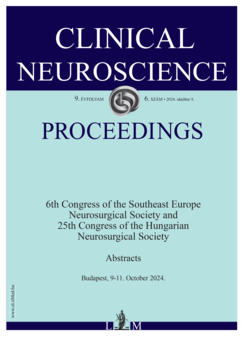Nutritional support of the neurosurgical patient
DORA Katanec1
2024. OKTÓBER 09.
Ideggyógyászati Szemle Proceedings - 2024;9(6)
DORA Katanec1
2024. OKTÓBER 09.
Ideggyógyászati Szemle Proceedings - 2024;9(6)
Szöveg nagyítása:

An important component in the process of treatment and recovery of neurosurgical patients is the provision of foods that meet their nutritional needs. injuries, psychological dysfunctions and stress often change the nutritional needs, the utilization of nutrients and fluids that are needed to meet the basic functions of the cells and for the recovery of the injured tissue. injured tissues require more protein, carbohydrates, fat, water and oxygen than healthy, uninjured tissue. Nutritional changes caused by the disease directly affect adequate nutrition and normal bodily function.
Patients with neurological disorders may have disorders of the level of consciousness, or paresis/paralysis of the chewing and swallowing muscles, which prevents adequate food intake. Taking into account the above-mentioned factors together with the effect of the disease on other systems, a special complexity is created in meeting the nutritional needs of the neurosurgical patient. Approaching the patient holistically, nutritional needs must not be neglected considering that the patient will not recover without adequate nutritional support.
Critically ill adults in the intensive care unit (ICU) are at increased risk of impaired nutritional status, because the body responds to serious illness by increasing metabolism. Also, feeding routines can be disrupted because patients are unconscious or too weak to feed or eat normally. This means that alternative feeding methods should be used to ensure adequate nutrition for the patient. Patients can be given artificial nutrition in three ways: enteral nutrition through the digestive system (through a tube placed in the stomach or small intestine); parenteral nutrition through the circulatory system (through a tube inserted into a vein, nutrients enter the bloodstream directly); or through a combination of both ways. This systematic review compares the effectiveness of these feeding methods.
Ideggyógyászati Szemle Proceedings
Despite evidence based institutional protocols being in place in many countries, aneurysmal subarachnoid hemorrhage (SAH) continues to be a major socio-economic burden with many open questions remaining regarding the optimal management of the affected patients.
Ideggyógyászati Szemle Proceedings
Arteriovenous malformation (AVM) is an anomaly of blood vessel formation. Numerous models have been established to understand the nature of AVM.
Ideggyógyászati Szemle Proceedings
Additive manufacturing has gained significant traction in industrial applications due to its high potential when it comes to manufacturing objects with complex geometry.
Ideggyógyászati Szemle Proceedings
Not only other surgical and robotic fields, but minimally invasive procedures in spine surgery have undergone significant development in recent times. A demand emerged from both surgeons and patients to develop and perform these types of surgeries in order to prevent biomechanical and surgical complications.
Ideggyógyászati Szemle Proceedings
Functional magnetic resonance imaging (fMRI) is crucial for presurgical language mapping in neurosurgery, helping identify eloquent brain regions to preserve during operations. Effective language mapping depends on advanced fMRI acquisition and detailed data analysis to ensure accurate clinical outcomes.
Ideggyógyászati Szemle
A fájdalomkutatás leggyakrabban tanulmányozott aspektusa klinikai vizsgálatokban a fájdalomintenzitás. Ennek mérése az ágyéki gerincbeteg populációban legtöbb esetben a numerikus skála és a vizuális analóg skála (VAS) segítségével történik. A betegek általános életminősége és a skálák közötti kapcsolat kiszámításával meghatározzuk a klinikailag relevánsabb információval rendelkező mérőeszközt.
Hypertonia és Nephrologia
A 2-es típusú cukorbetegség gyakori szövődményei a krónikus veseelégtelenség és a krónikus szívelégtelenség. A krónikus veseelégtelenség és a krónikus szívelégtelenség azonban egymás kialakulását és romlását is segíthetik, illetve korábban és súlyosabban jelentkezhetnek cukorbetegség esetén. Továbbá, a krónikus vese-, illetve szívelégtelenség esetén a 2-es típusú cukorbetegség is gyakrabban fordulhat elő.
Ideggyógyászati Szemle Proceedings
A Magyar Neuroimmunológiai Társaság X. Kongresszusa Absztraktfüzet Siófok, Magyarország 2023. október 26–28.
Ideggyógyászati Szemle Proceedings
Additive manufacturing has gained significant traction in industrial applications due to its high potential when it comes to manufacturing objects with complex geometry.
Ideggyógyászati Szemle Proceedings
Functional magnetic resonance imaging (fMRI) is crucial for presurgical language mapping in neurosurgery, helping identify eloquent brain regions to preserve during operations. Effective language mapping depends on advanced fMRI acquisition and detailed data analysis to ensure accurate clinical outcomes.
Surgical management of degenerative scoliosis in a neurosurgical department: Analysis of a series of 15 patients
Szoptatástámogatás a gyermekágyas osztályokon
1.
2.
3.
4.
5.
Egészségpolitika
Hadiállapotként kezeli és így is reagál a kormány az egészségügy „rendezésére”1.
Orvoslás és társadalom
Országos férfiegészség-kampány és PSA-szűrés indul a prosztatarák ellen2.
3.
4.
5.